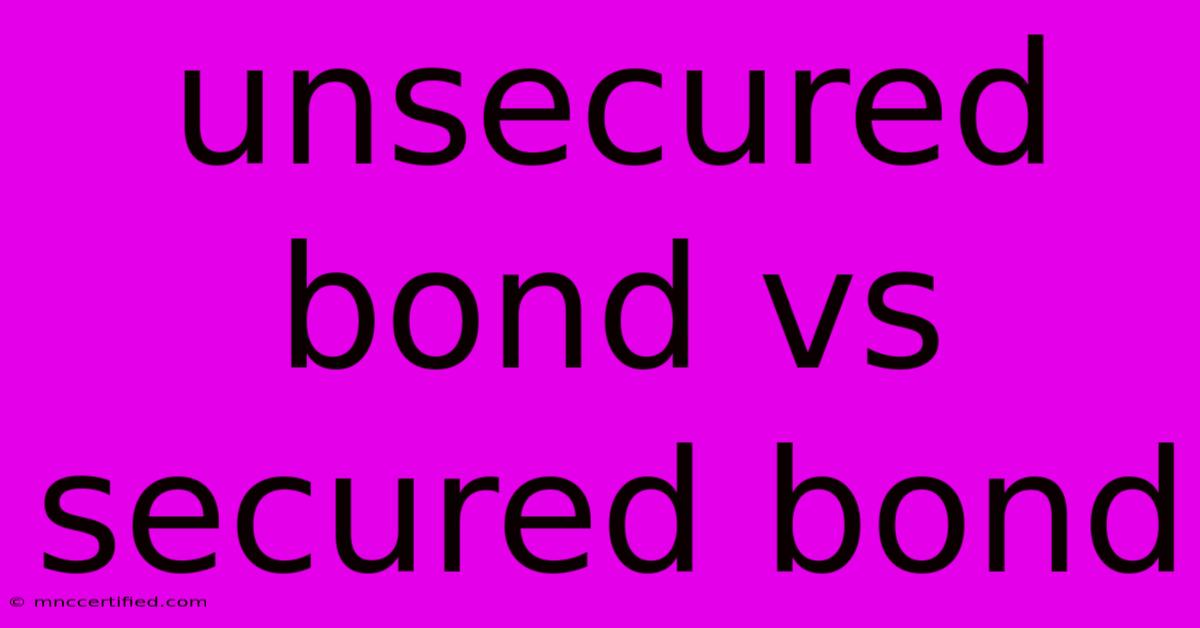Unsecured Bond Vs Secured Bond

Table of Contents
Unsecured Bond vs. Secured Bond: A Comprehensive Guide for Investors
Investing in bonds can be a smart way to diversify your portfolio and generate relatively stable income. However, understanding the nuances of different bond types is crucial for making informed investment decisions. Two fundamental categories are unsecured bonds and secured bonds. This article will delve into the key differences between these two types of bonds, helping you determine which is the better fit for your investment strategy.
What is a Secured Bond?
A secured bond, also known as a collateralized bond, is backed by a specific asset of the issuing company. This asset, which serves as collateral, acts as security for the bondholders. If the issuer defaults on its payment obligations, the bondholders have the right to seize and sell the collateral to recover their investment. Common types of collateral include:
- Real estate: Mortgages or other real estate holdings can secure bonds, offering a tangible asset to back the debt.
- Equipment: Companies might use machinery or equipment as collateral for secured bonds.
- Other assets: Depending on the issuer and the bond agreement, other assets like inventories or accounts receivable can also secure the bond.
Advantages of Secured Bonds:
- Lower risk: The presence of collateral significantly reduces the risk of default for bondholders. If the issuer defaults, bondholders have a higher chance of recovering at least a portion of their investment through the sale of the collateral.
- Potentially lower interest rates: Because of the lower risk, secured bonds often offer lower interest rates compared to unsecured bonds.
Disadvantages of Secured Bonds:
- Limited upside potential: The lower risk typically translates to lower returns compared to higher-risk investments.
- Complexity of collateral evaluation: Assessing the true value and liquidity of the collateral can be complex and requires specialized knowledge.
What is an Unsecured Bond?
An unsecured bond, also known as a debenture, is not backed by any specific asset. Instead, it relies solely on the creditworthiness of the issuer. Bondholders' claims are subordinate to those of secured creditors in case of bankruptcy.
Advantages of Unsecured Bonds:
- Potentially higher yields: Because of the higher risk associated with unsecured bonds, they typically offer higher interest rates to compensate investors.
Disadvantages of Unsecured Bonds:
- Higher risk of default: The lack of collateral increases the risk of significant losses if the issuer defaults.
- Lower priority in bankruptcy: Unsecured bondholders are at the bottom of the priority list in a bankruptcy proceeding, meaning they may receive little to nothing if the company's assets are insufficient to cover all its debts.
Unsecured Bond vs. Secured Bond: A Direct Comparison
| Feature | Secured Bond | Unsecured Bond |
|---|---|---|
| Collateral | Backed by specific assets | No collateral |
| Risk | Lower | Higher |
| Interest Rate | Typically lower | Typically higher |
| Priority in Bankruptcy | Higher | Lower |
| Investment Strategy | Conservative, risk-averse investors | Investors seeking higher returns, accepting higher risk |
Choosing the Right Bond for You
The best type of bond for you depends on your individual investment goals, risk tolerance, and investment horizon. If you prioritize capital preservation and are risk-averse, secured bonds might be a more suitable option. However, if you are willing to accept higher risk in pursuit of potentially higher returns, unsecured bonds could be considered.
Disclaimer: This article provides general information and does not constitute financial advice. Consult with a qualified financial advisor before making any investment decisions. The information provided is for educational purposes only and should not be considered a recommendation to buy or sell any specific security.

Thank you for visiting our website wich cover about Unsecured Bond Vs Secured Bond. We hope the information provided has been useful to you. Feel free to contact us if you have any questions or need further assistance. See you next time and dont miss to bookmark.
Featured Posts
-
Dear Santa On Paramount Plus Streaming Guide
Nov 26, 2024
-
Chargers Activate Deane Leonard
Nov 26, 2024
-
Court Hearing Menendez Brothers Together
Nov 26, 2024
-
Bond County Il Property Search
Nov 26, 2024
-
Ronaldos Double Leads Al Nassr Past Al
Nov 26, 2024